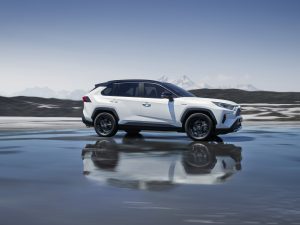Toyota Safety Sense: One Step Closer to an Automotive Society with Zero Accidents
In 2015, Toyota decided to instigate the democratisation of advanced safety features in its cars with Toyota Safety Sense, a set of active safety technologies designed to help prevent or mitigate collisions across a wide range of traffic situations. The ethos was to make these systems widely available across its model ranges, rather than reserving their use to higher specification vehicles, thus increasing their potential to reduce accidents and injuries.
Since then, more than eight million Toyota vehicles worldwide have been fitted with Toyota Safety Sense. In real-world traffic conditions, the resultant effects of accident reduction1 can be clearly seen, such as a reduction in rear-end collisions of approximately 50 per cent, rising to approximately 90 per cent in conjunction with the Intelligent Clearance Sonar (ICS).
Toyota is committed to achieving a safe mobility society and believes it is important to promote an approach which involves people, vehicles, and the traffic environment, as well as the pursuit of ‘real-world safety’ by learning from accidents and incorporating that knowledge into vehicle development.
Moving one step closer to its ultimate goal of an automotive society with zero accidents, Toyota is now rolling out the second generation of Toyota Safety Sense.
The upgraded active safety package features a single-lens camera and millimetre-wave radar. The performance of both systems has been enhanced to expand the scope of hazard detection and improve functionality. The new system unit has also been reduced in size for ease of installation across the Toyota model line-up.
Toyota Safety Sense now includes2 upgraded versions of the Pre-Collision System (PCS), Adaptive Cruise Control (ACC), Lane Departure Alert (LDA), Road Sign Assist (RSA) and Automatic High Beam (AHB). In addition, it introduces a new Lane Trace Assist (LTA) for advanced driving support.
Pre-Collision System (PCS)
On all Toyotas equipped with the second generation Toyota Safety Sense, the upgraded PCS now detects vehicles in front between speeds of approximately six and 112mph, and reduces the risk of hitting them from behind. When there is a collision risk, PCS prompts the driver to brake with an audible and visual alert. It also primes the brake system to deliver extra stopping force when the driver presses the brake pedal. If the driver fails to react in time, the system automatically applies the brakes, reducing speed by approximately 31mph3 or even bringing the car to a complete stop, in order to prevent the collision or mitigate the force of impact.
The PCS operating conditions have been further upgraded, enabling the system to also detect potential collisions with pedestrians during both day and night time driving, and cyclists during daytime, in the event of which automated braking operates at relative speeds of between six to 50mph, and can reduce speed by approximately 25mph4.
Adaptive Cruise Control (ACC)
ACC helps the driver to keep a safe distance from the car in front. It detects preceding vehicles and determines their speed, then adjusts vehicle speed to ensure that there is a safe distance between both cars.
The upgraded ACC benefits from improved acceleration and deceleration control for enhanced performance and greater comfort, and can be easily controlled using new steering wheel-mounted switchgear.
ACC now includes low-speed following and stop-start driving at speeds between zero and approximately 19mph. In congested traffic, the Toyota will stop when the vehicle ahead comes to a stop, maintaining an appropriate distance. The driver then restarts the vehicle, using either the accelerator pedal or the steering wheel-mounted switchgear, reactivating the ACC system.
At speeds over 44mph, smooth overtaking of preceding vehicles is enhanced by side-indicator-linked control. When following a vehicle that is travelling slower than the Toyota’s speed setting, preliminary acceleration is applied when the driver operates the side-indicator to change lanes. If a vehicle is detected ahead in the overtaking lane, however, acceleration is suppressed to prevent a rapid approach, so the driver can overtake with peace-of-mind.
A new intelligent Adaptive Cruise Control (iACC) is now also available, linking the ACC with Road Sign Assist (RSA). When the vehicle travels at a constant speed in accordance with the speed pre-set by the driver, and a speed limit sign is recognised by RSA, the driver can easily reset the vehicle speed in accordance with the new speed limit, by using the switches on the steering wheel.
Lane Departure Alert (LDA)
At speeds above 31mph, LDA helps prevent accidents and head-on collisions caused by vehicles leaving their traffic lane. If the vehicle starts to deviate from its lane without the indicators having been engaged, LDA warns the driver with an audible and visual alert, and can provide steering input to help the driver return the vehicle to its intended course.
The upgraded system can now also recognise the road edge on straight roads without lane markings.
The Vehicle Sway Warning function detects the variation in vehicle behaviour which tends to occur when the driver starts to lose attentiveness or become tired, and alerts the driver with an audible and visual warning, urging the driver to take a break.
Lane Trace Assist (LTA)
Advanced driving support is being introduced through Lane Trace Assist (LTA), a new system which helps further reduce the burden on the driver.
When Adaptive Cruise Control (ACC) and LTA are active, the system assists the driver with steering control with gentle inputs to keep the vehicle centred in its lane, even on gentle highway curves.
LTA can operate from highway speeds down to almost standstill, to support the driver even in congested traffic. And if it’s difficult or not possible for the system to detect the lane markings, such as when they are faded, the car will follow the path of the preceding vehicle, as recognised by the camera and millimetre wave radar.
Vehicles equipped with LTA also support all LDA features.
Automatic High Beam (AHB)
AHB helps ensure excellent forward visibility during night-time driving. It detects both the headlights of oncoming vehicles and the tail lights of preceding vehicles, automatically switching between high and low beams to avoid dazzling other drivers. By using high beam more frequently, the system enables earlier detection of pedestrians and obstacles.
Road Sign Assist (RSA)
RSA supports drivers by ensuring they always have the best possible information, even if they may have, overlooked a road sign. System status and alert information is displayed to the driver on the multi-information display. In the case of speed limits, the system gives a visual and audible alert should the driver exceed the posted limit.
The system now recognises a larger number of traffic signs such as speed limit, no overtaking, road condition, stop and no entry signs, start/end of highways, urban and residential areas, and end of all restrictions.
The second generation Toyota Safety Sense will be progressively rolled out across the Toyota line-up, starting with the new RAV4 and Corolla.
1 Based on study conducted in Japan
2 Available features depend on model and grade
ENDS



